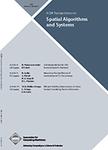版权所有:内蒙古大学图书馆 技术提供:维普资讯• 智图
内蒙古自治区呼和浩特市赛罕区大学西街235号 邮编: 010021

作者机构:Purdue Univ 305 N Univ St W Lafayette IN 47907 USA
出 版 物:《ACM TRANSACTIONS ON SPATIAL ALGORITHMS AND SYSTEMS》 (ACM Trans. Spat. Algorithms Syst.)
年 卷 期:2021年第7卷第2期
页 面:1–28页
核心收录:
基 金:National Science Foundation [1816514, 1835739] Direct For Computer & Info Scie & Enginr Div Of Information & Intelligent Systems Funding Source: National Science Foundation Office of Advanced Cyberinfrastructure (OAC) Direct For Computer & Info Scie & Enginr Funding Source: National Science Foundation
主 题:Procedural modeling uncertain spatial data deep learning urban modeling content creation satellite imagery 3D urban modeling
摘 要:Recent advances in big spatial data acquisition and deep learning allow novel algorithms that were not possible several years ago. We introduce a novel inverse procedural modeling algorithm for urban areas that addresses the problem of spatial data quality and uncertainty. Our method is fully automatic and produces a 3D approximation of an urban area given satellite imagery and global-scale data, including road network, population, and elevation data. By analyzing the values and the distribution of urban data, e.g., parcels, buildings, population, and elevation, we construct a procedural approximation of a city at a large-scale. Our approach has three main components: (1) procedural model generation to create parcel and building geometries, (2) parcel area estimation that trains neural networks to provide initial parcel sizes for a segmented satellite image of a city block, and (3) an optional optimization that can use partial knowledge of overall average building footprint area and building counts to improve results. We demonstrate and evaluate our approach on cities around the globe with widely different structures and automatically yield procedural models with up to 91,000 buildings, and spanning up to 150 km(2). We obtain both a spatial arrangement of parcels and buildings similar to ground truth and a distribution of building sizes similar to ground truth, hence yielding a statistically similar synthetic urban space. We produce procedural models at multiple scales, and with less than 1% error in parcel and building areas in the best case as compared to ground truth and 5.8% error on average for tested cities.